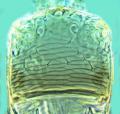Proscirtothrips zeae
Recognition data
Distinguishing features
Females usually without wings or ocelli, sometimes both sexes fully winged. Body and legs yellow, distal antennal segments light brown. Head longer than wide, slightly overhanging bases of antennae; three pairs of ocellar setae present, pair III prominent; compound eyes with six pigmented ommatidia. Antennae 9-segmented; sensorium simple on segment III, forked on IV. Pronotum with one pair of prominent posteroangular setae. Mesonotum transverse, with group of about six small setae laterally in wingless form. Metanotum transverse, no campaniform sensilla. Abdominal tergites with transverse reticulation, median setae wide apart; tergite VIII with complete comb of short irregular microtrichia. Sternites without discal setae.
Related and similar species
The genus Proscirtothrips includes only one species, although this has three junior synonyms. This has the general appearance of an Anaphothrips species, but with one pair of prominent pronotal posteroangular setae.
Taxonomic data
Current valid name
Proscirtothrips zeae (Moulton)
Original name and synonyms
- Anaphothrips zeae Moulton, 1911: 28
- Anaphothrips longipennis Crawford DL, 1910: 150
- Anaphothrips hesperus Moulton, 1911: 17
- Scirtothrips crawfordi Priesner, 1932: 152 [replacement name]
Family placement
Thripidae, Thripinae
Biological data
Life history
Presumably breeding on leaves
Host plants
Probably Poaceae
Tospoviruses vectored
None
Crop damage
None
Distribution data
Area of origin
Western USA
Distribution
California, Oregon, Arizona, Nevada, Utah, Idaho, South Dakota







